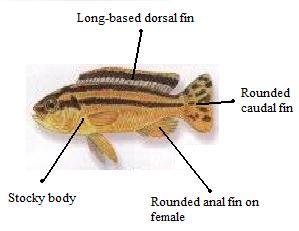Cichlids: Difference between revisions
imported>Drew R. Smith No edit summary |
imported>Drew R. Smith No edit summary |
||
| Line 4: | Line 4: | ||
[[Image:Cichliddiagram.jpg|right|400x400px]]The 1,000 or more members of the cichlid family are native to Central and South America, Africa, Asia, and parts of the USA. Most will acclimatize well to domestic tap water, although some species, such as the [[Discus Fish]], need carefully controlled water. | [[Image:Cichliddiagram.jpg|right|400x400px]]The 1,000 or more members of the cichlid family are native to Central and South America, Africa, Asia, and parts of the USA. Most will acclimatize well to domestic tap water, although some species, such as the [[Discus Fish]], need carefully controlled water. | ||
The colors, shapes, and sizes of cichlids vary enormously, although they tend to be heavily built. Some grow to large for the average community tank, while others breed readily among other fishes in any aquarium. Male cichlids from the Americas may have longer, more pointed dorsal and anal fins, while male African Rift Valley cichlids often have yellow or orange spots on the anal fin. There is plenty of opportunity for specialization within this family: Rift Valley cichlids, for example, prefer hard water and rocky furnishings. Many are herbivorous, requiring vegetable foods. Cichlids are hearty eaters and produce a lot of waste, which calls for frequent water changes. Generally these fishes reproduce by egg-depositing, but they display diverse methods of breeding, all of which involve a high degree of parental care. | The colors, shapes, and sizes of cichlids vary enormously, although they tend to be heavily built. Some grow to large for the average community tank, while others breed readily among other fishes in any aquarium. Male cichlids from the Americas may have longer, more pointed dorsal and anal fins, while male African Rift Valley cichlids often have yellow or orange spots on the anal fin. There is plenty of opportunity for specialization within this family: Rift Valley cichlids, for example, prefer hard water and rocky furnishings. Many are herbivorous, requiring vegetable foods. Cichlids are hearty eaters and produce a lot of waste, which calls for frequent water changes. Generally these fishes reproduce by egg-depositing, but they display diverse methods of breeding, all of which involve a high degree of parental care.<noinclude> | ||
{{:Small Cichlids}} | |||
{{:Large Cichlids}} | |||
{{:Freshwater Angelfishes}} | |||
{{:Discus Fishes}} | |||
{{:Rift Valley Cichlids}} | |||
{{:Cichlids/Bibliography}} | |||
{{:Cichlids/Related Articles}} | |||
</noinclude> | |||
Revision as of 19:33, 9 September 2009
The 1,000 or more members of the cichlid family are native to Central and South America, Africa, Asia, and parts of the USA. Most will acclimatize well to domestic tap water, although some species, such as the Discus Fish, need carefully controlled water.
The colors, shapes, and sizes of cichlids vary enormously, although they tend to be heavily built. Some grow to large for the average community tank, while others breed readily among other fishes in any aquarium. Male cichlids from the Americas may have longer, more pointed dorsal and anal fins, while male African Rift Valley cichlids often have yellow or orange spots on the anal fin. There is plenty of opportunity for specialization within this family: Rift Valley cichlids, for example, prefer hard water and rocky furnishings. Many are herbivorous, requiring vegetable foods. Cichlids are hearty eaters and produce a lot of waste, which calls for frequent water changes. Generally these fishes reproduce by egg-depositing, but they display diverse methods of breeding, all of which involve a high degree of parental care.
Smaller Cichlids
The family Cichlidae comprises a large number of mostly heavy bodied fishes that are widely distributed throughout Central and South America, tropical Africa, and, to a lesser extent, southern Asia. They generally live in still or slow-moving waters, sheltering among rocks and vegetation. As males vigorously defend their territory in the wild, a single pair is usually suitable for the average aquarium. Some cichlids dig to lay their eggs in the substrate, so rooted plants in the tank will be prone to damage. The smaller cichlids, or dwarf cichlids, include Apistogramma and Pelvicachromis species. They tend to be secretive spawners, often laying their eggs inside caves or in the aquarium equivalent - an overturned flowerpot. Large Cichlids Freshwater Angelfishes Discus Fishes Rift Valley Cichlids Cichlids/Bibliography
Related Articles
Parent topics
- Fish [r]: Any aquatic vertebrate animal that is typically ectothermic (or cold-blooded), covered with scales, and equipped with two sets of paired fins and several unpaired fins. [e]
